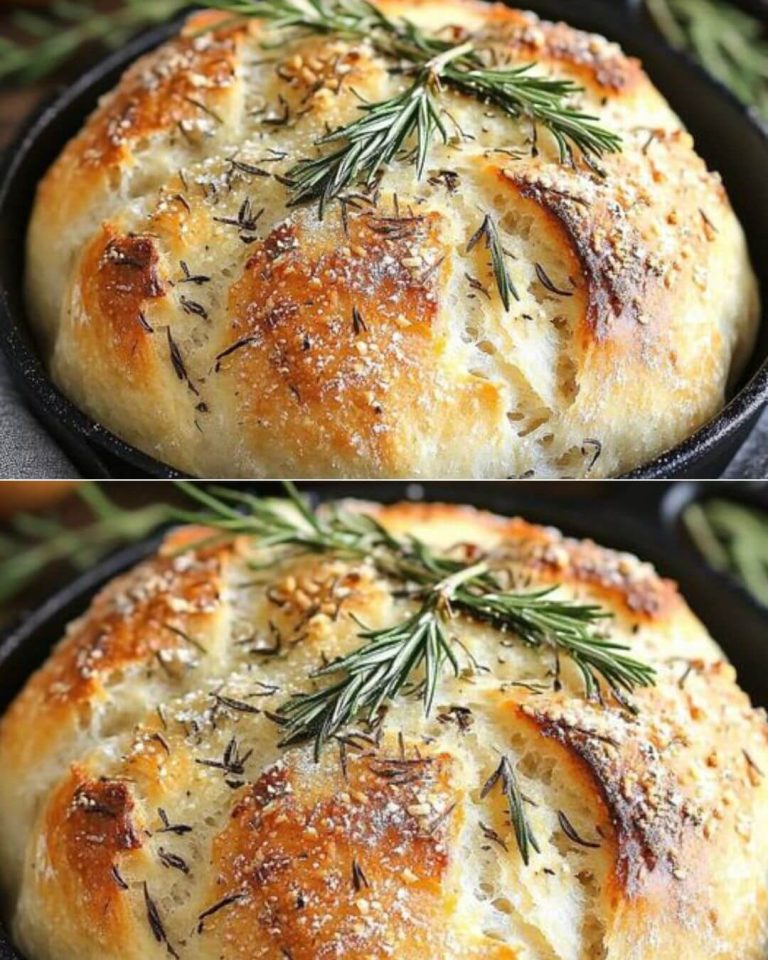If you’ve ever dreamed of baking bakery-quality bread at home—without kneading or complicated steps, this no-knead rosemary garlic loaf is your answer. Inspired by traditional Italian techniques, this recipe balances old-world flavor with modern convenience. With just a few minutes of prep and a long, slow fermentation, you’ll get a deeply flavorful, crusty loaf worthy of any artisan bakery.
The real secret? A cast iron skillet, a few simple ingredients, and a whole lot of aromatic magic from fresh rosemary and garlic.
⏱️ Time at a Glance
- Prep Time: 15 minutes
- First Rise: 18–24 hours
- Second Rise: 2 hours
- Bake Time: 30–40 minutes
- Total Time: 20–27 hours
- Servings: 8
🧂 Ingredients
- 3 cups all-purpose flour (375g)
- 3 cloves garlic, minced (15g)
- 1 tbsp fresh rosemary, finely chopped (3g)
- 1¼ tsp kosher salt (7g)
- ¾ tsp freshly ground black pepper (2g)
- ½ tsp instant yeast (2g)
- 1½ cups room-temperature water (350ml)
- 2 tbsp cornmeal (20g) for the skillet
🍞 Step-by-Step Instructions
1. Mix Your Dry Ingredients
Finely mince the garlic and chop the rosemary. In a large bowl, combine flour, garlic, rosemary, salt, pepper, and yeast. Mix thoroughly to evenly distribute everything.
2. Add Water and Stir
Pour in the water and stir with a wooden spoon or your hands until a shaggy, sticky dough forms—this takes about 30 seconds. Don’t try to smooth it out; the dough will look rough, and that’s perfect.
3. Let It Rise (First Fermentation)
Cover the bowl tightly with plastic wrap and let the dough rest at room temperature (around 70°F/21°C) for 18 to 24 hours. The surface should be dotted with bubbles and slightly domed when ready.
4. Prep the Skillet
Coat a 10-inch cast iron skillet with oil or nonstick spray. Sprinkle cornmeal across the bottom—this keeps the bread from sticking and adds a delicious crunch.
5. Shape the Dough
Lightly flour your surface and turn out the dough. It’ll be very sticky, so use floured hands to gently form it into a round loaf. Handle as little as possible to preserve the air bubbles.
6. Second Rise
Transfer the shaped loaf to the skillet. Cover with a clean kitchen towel and let it rise for about 2 hours. It should roughly double in size and slowly spring back when lightly poked.
7. Bake to Golden Perfection
About 30 minutes before baking, preheat your oven to 450°F (230°C). Bake the loaf in the skillet for 30–40 minutes, until it’s golden brown and sounds hollow when tapped on the bottom. For best results, the internal temperature should reach 190°F (88°C).
🔥 Pro Tips for Perfect Bread
- Use fresh rosemary – Dried lacks the fragrant punch.
- Stick with room-temp water – Too hot or cold can slow the yeast.
- Expect a wet dough – That’s what gives the bread its open, airy texture.
- Don’t skip the cornmeal – It prevents sticking and adds crunch.
- Cool before slicing – Let the loaf rest at least 30 minutes to finish setting.
🧾 Nutrition (Per Serving)
- Calories: 165
- Protein: 4.5g
- Carbs: 34g
- Fiber: 1.2g
- Fat: 0.5g
- Sodium: 365mg
🍽️ Serving & Storage Suggestions
This loaf is best served warm, fresh from the oven—dipped in olive oil or slathered with butter. If you have leftovers, store in a paper bag at room temperature for 2–3 days. In fact, the rosemary and garlic flavors deepen over time, making it even better the next day for toast or grilled cheese.
⏳ Final Thoughts
Patience is the key ingredient here. The long, slow rise is what creates the deep flavor and airy crumb that make this loaf so special. With just a bit of planning, you’ll be rewarded with a rustic, golden-brown beauty that rivals anything from an artisan bakery—right from your own oven.


